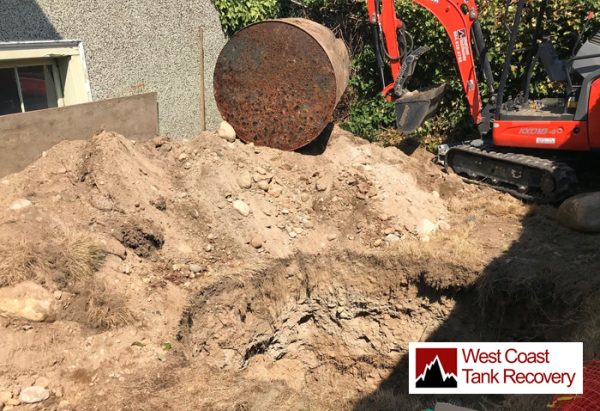 Fully Licensed and Insured
Fully Licensed and Insured Request an Oil Tank Scan
Request an Oil Tank Scan Request a Free Estimate
Request a Free Estimate

Owning a home is a significant investment, and as a homeowner, you want to do everything within your power to protect that investment and mitigate potential risks. We buy home insurance, and stay on top of maintenance issues, and other potential issues that may arise. However, despite all your best efforts one often overlooked danger, especially in older homes, is the presence of underground oil tanks.
For a long time, oil was the most common form of heating in British Columbia. While we have since shifted away from oil to more environmentally conscious methods of heating and cooling, many of the tanks used to store oil remain buried on properties throughout the province. Although hidden from sight, these decommissioned oil tanks pose severe environmental and financial risks if not properly managed. Understanding your liability as a homeowner regarding underground oil tanks and soil remediation is crucial for protecting your property and complying with environmental regulations.
When oil tanks were originally placed on properties, their usable lifespan was anticipated to be around 20 years before they needed to be replaced. For most of these tanks, that expiration date has long passed. And that’s where the problem lies.
Over time, these aging tanks can corrode and leak, contaminating the surrounding soil and groundwater. This contamination not only poses environmental hazards but also can significantly affect property value and lead to financial and legal liabilities for homeowners.
As a homeowner in BC, you are responsible for the environmental condition of your property, including any contamination caused by an underground oil tank. The BC Fire Code mandates that homeowners must remove an underground oil tank if one is discovered on their property. This liability now extends to any existing but decommissioned tanks.
Unfortunately, most homeowner’s insurance policies will not cover the cost of soil remediation services. What’s more, the presence of an underground oil tank on your property will also prevent you from being able to obtain home insurance until it has been removed and the surrounding soil has been tested for the presence of contaminates.
If an underground oil tank leaks, causing soil and groundwater contamination, the homeowner is entirely responsible for the cleanup costs. This can include soil remediation, groundwater treatment, and disposal of the old tank. Not only are you responsible for the full cost of soil remediation services on your property, but if testing finds contaminates on neighbouring properties resulting from your tank, you are responsible for those costs as well. While the full scope of these services will vary based on several factors, such as *** the cost of remediation can be substantial, often ranging from several thousand to tens of thousands of dollars.
When selling a property, undisclosed underground oil tanks can complicate the transaction. Prospective buyers purchasing in an area known to have underground oil tanks can request an environmental site assessment that indicates there is no oil tank on the property, proof that the oil tank was professionally removed, including soil tests, or request an oil scan be performed as part of the home inspection process and hold back on a portion of funds in case removal and soil remediation are required. Failure to disclose known tanks or contamination is considered a misrepresentation of material latent defects by BC real estate law and can lead to legal action.
Understanding your liability as a homeowner regarding underground oil tanks and soil remediation services is crucial for protecting your investment and ensuring environmental safety. By proactively managing these risks you can safeguard your property and contribute to a healthier environment in BC.